Remote working has transformed the way we build businesses and careers. Studies show that remote workers are happier in their jobs and life in general, which keeps them working in the same position for longer while maintaining a healthier work-life balance.
For businesses, remote working makes it easier to recruit and retain top talent from around the world while keeping their organisation lean and flexible enough to adapt to changing demands. This has been instrumental in the rise of startup culture and businesses adapting to digital technologies.
Unsurprisingly, there’s a lot of hype surrounding remote working these days but it’s important to understand the challenges it comes with. There’s no such thing as a perfect working model and, despite the benefits to businesses and employees, there are some downsides that need to be mitigated in order to maximise those benefits.
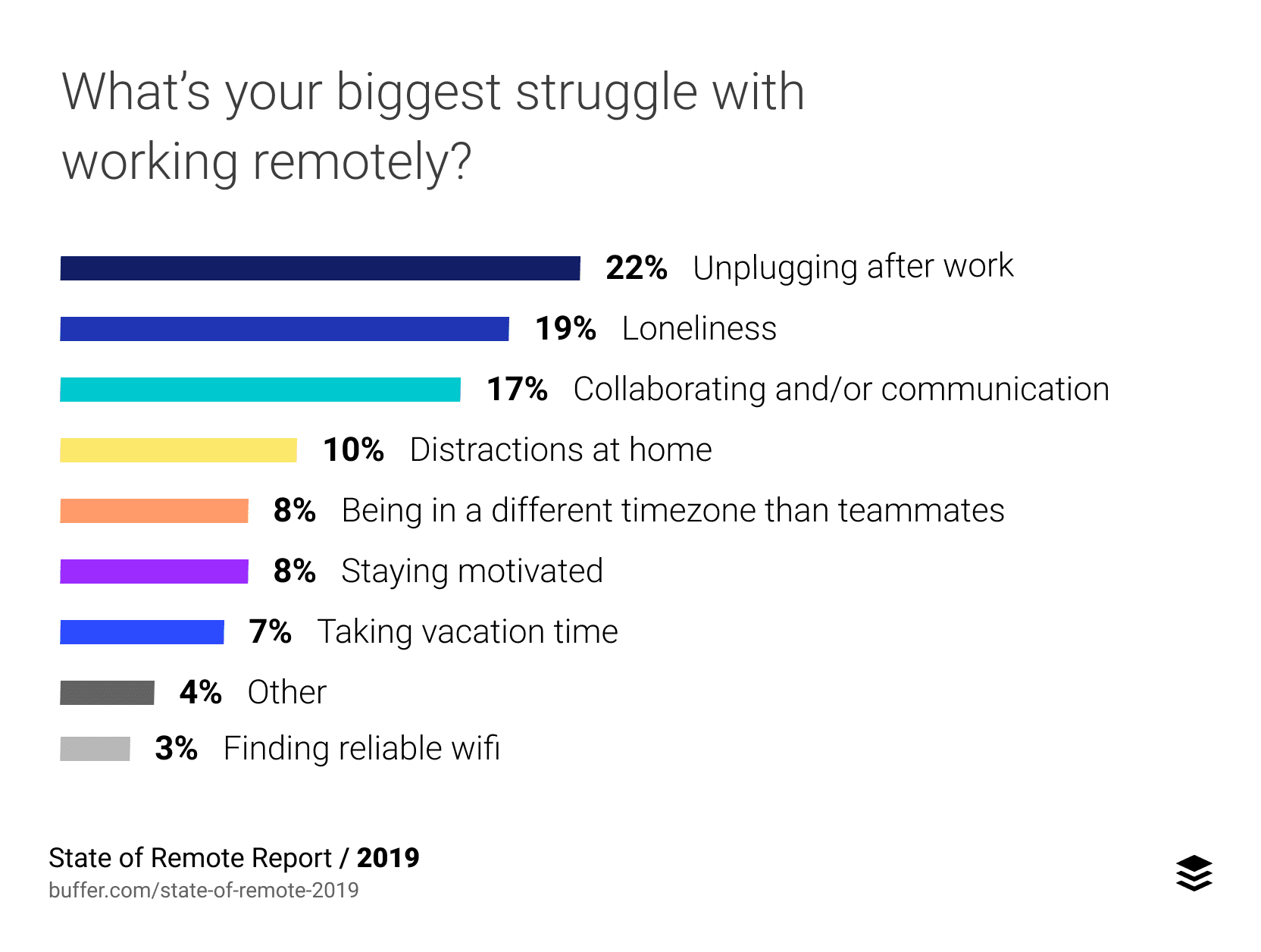
According to Buffer’s 2019 State of Remote Report, the biggest challenge remote workers have is switching off after work (22%) while loneliness (19%) is an issue that can’t be ignored. Remote workers also admit that collaborating and communicating with team members can be a challenge (17%) and distractions at home (10%) can get in the way of productivity, which is an obvious concern to businesses and employees alike.
As a remote member of the Venture Harbour team myself, I can attest to these challenges (among others) and how we’ve overcome them within our team. Remote working is crucial to our business model and maximising productivity – both collectively and individually – has been a key priority for us.
In this article, we’re looking at 12 remote working best practices that we’ve discovered the hard way over the past eight years.
#1: Stop multitasking – it doesn’t work
The biggest lesson we’ve learned in our pursuit of ultimate productivity is this: multitasking simply doesn’t work. This isn’t only based on our own experience here at Venture Harbour, either; this is backed by a whole bunch of science.
Let’s be clear about this, the human brain isn’t designed for multitasking.
“For nearly all people, in nearly all situations, multitasking is impossible. When we think we’re multitasking, most often we aren’t really doing two things at once – but instead, individual actions in rapid succession.” – Cleveland Clinic academic centre
Likewise, constantly switching between one task and another, significantly reduces our effectiveness of both tasks. This is obviously bad news for productivity but a string of studies have revealed some more sinister side-effects of forcing our brains to handle more than one task at a time.
The full cost of multitasking
A series of studies looking into how the human brain copes with handling multiple tasks at the same time or constantly switching between tasks reveal some important findings.
The full cost of multitasking includes a number of immediate and long-term consequences:
- Reduces productivity by up to 40%
- Lowers the quality of your work
- Leads to compromises, mistakes and shortcuts
- Reduces your IQ
- Damages your brain
Neuroscientists have found that overloading the brain with multiple tasks declines IQ scores to a similar extent to that expected of smoking marijuana or staying up all night. Meanwhile, ongoing multitasking has been linked to the development of “grey matter” in the brain during a study on people using their smartphones while watching another media device.
The science makes for some pretty stark reading – not only in terms of productivity but also the long-term health of remote workers.
Breaking the habit
Despite knowing the fact that multitasking doesn’t work and actually kills productivity, breaking the habit is surprisingly difficult. It’s always tempting to think we can get more done by doing two things at the same time while the constant barrage of email notifications and other distractions only make focusing on a single task more difficult.
Modern life programmes us to do multiple things at the same time while simultaneously failing to prioritise busyness over productivity.
It turns out I wasn’t the only member of our team who found it difficult to kick the multitasking habit, even after learning how counterproductive it really is. So we started looking for practical solutions that would help us focus on single tasks – and this led us to Serene.
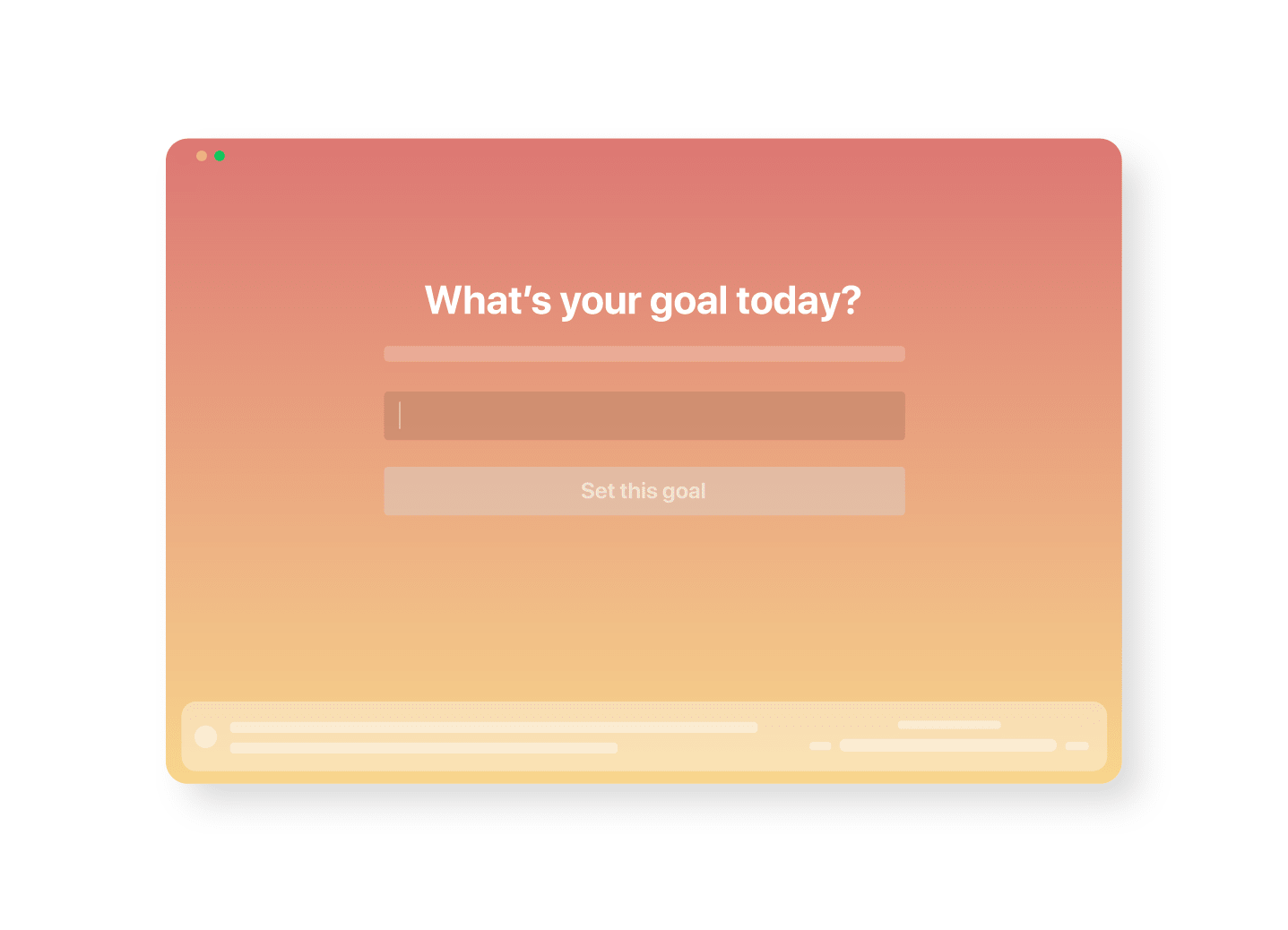
Serene is a productivity app that encourages team members to define a single goal for each day, which can comprise of multiple tasks they’ll deal with, one at a time. This allows our entire team to shift its daily mentality to achieving one thing every day and maximising productivity on achieving each goal.
On a personal basis, setting out my daily workload in this way helps me stay focused on single tasks but it also removes the pressure I used to feel to handle multiple tasks at once. Now, our entire team has the shared mentality that multitasking is bad for us. We no longer expect this from each other and we also no longer feel pressured to take on more than one task at any time.
Our entire business culture has changed and this is crucial for maximising productivity.
#2: Work in distraction-free bursts
Another reason that multitasking is so tempting is that it can be difficult to focus on the same task for extended periods of time. Multitasking offers a kind of break from the task we’re doing but it’s a false positive in terms of productivity.
To get the full benefits from single-tasking and remote productivity, we needed a way to improve our individual focus on each task.
The Pomodoro Technique
Luckily, there are already tried and tested working models that are proven to enhance focus and productivity at the same time. The Pomodoro Technique is a time management strategy first developed in the 1980s and it’s become a favourite among productivity advocates in recent years.
Essentially, the technique encourages people to work in 25-minute bursts, separated by short breaks. Studies have shown the human brain can only focus on single tasks for roughly 20 minutes (sometimes less) before cognitive effectiveness starts to deteriorate – and this is a key principle of the Pomodoro Technique.
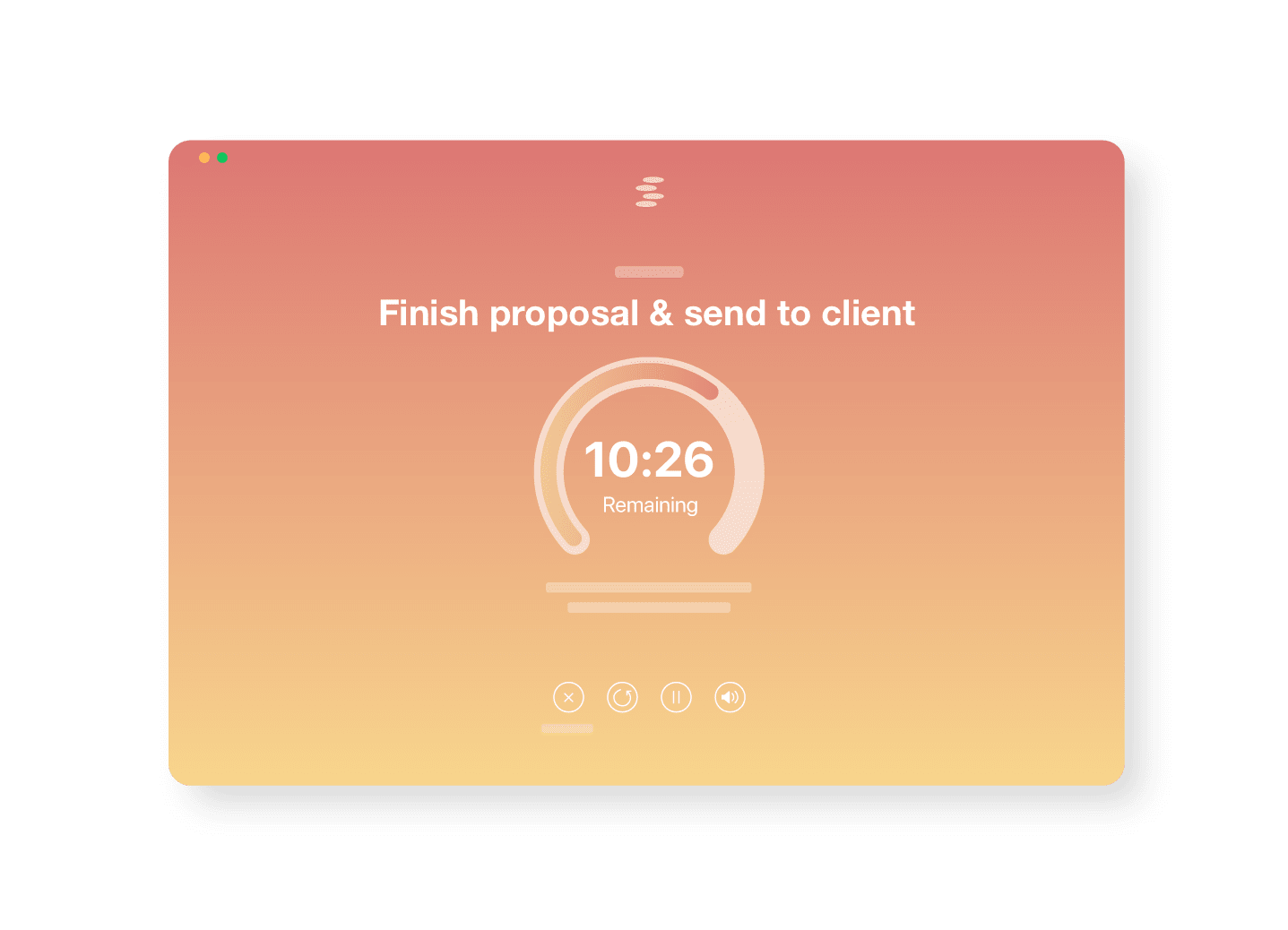
The Pomodoro Technique strongly inspired the design of Serene, which allows you to create working sessions of 20-60 munites with regular breaks. Aside from making it easier to focus on tasks, I naturally find my energy levels remain high throughout these sessions as I’m working to the clock in smaller intervals.
Essentially, I’m hitting half a dozen targets throughout the day instead of aiming to complete a full to-do list by the end of the day.
Personally, I now break each hour into two 25-minute bursts with a five-minute break at the end of each burst. This allows me to structure the day into hour intervals and take slightly longer breaks after each two-hour interval.
Blocking out the distractions
Another telling insight from scientific studies is that it takes us an average of 23 minutes to refocus after becoming distracted (PDF). That’s a pretty shocking statistic by anyone’s standards but you can see how the idea of working in 25-minute bursts falls apart once you get distracted by email notifications or messages from other team members.
To combat this, we had to come up with a way to block out these distractions and this went on to become one of the most important features of Serene.
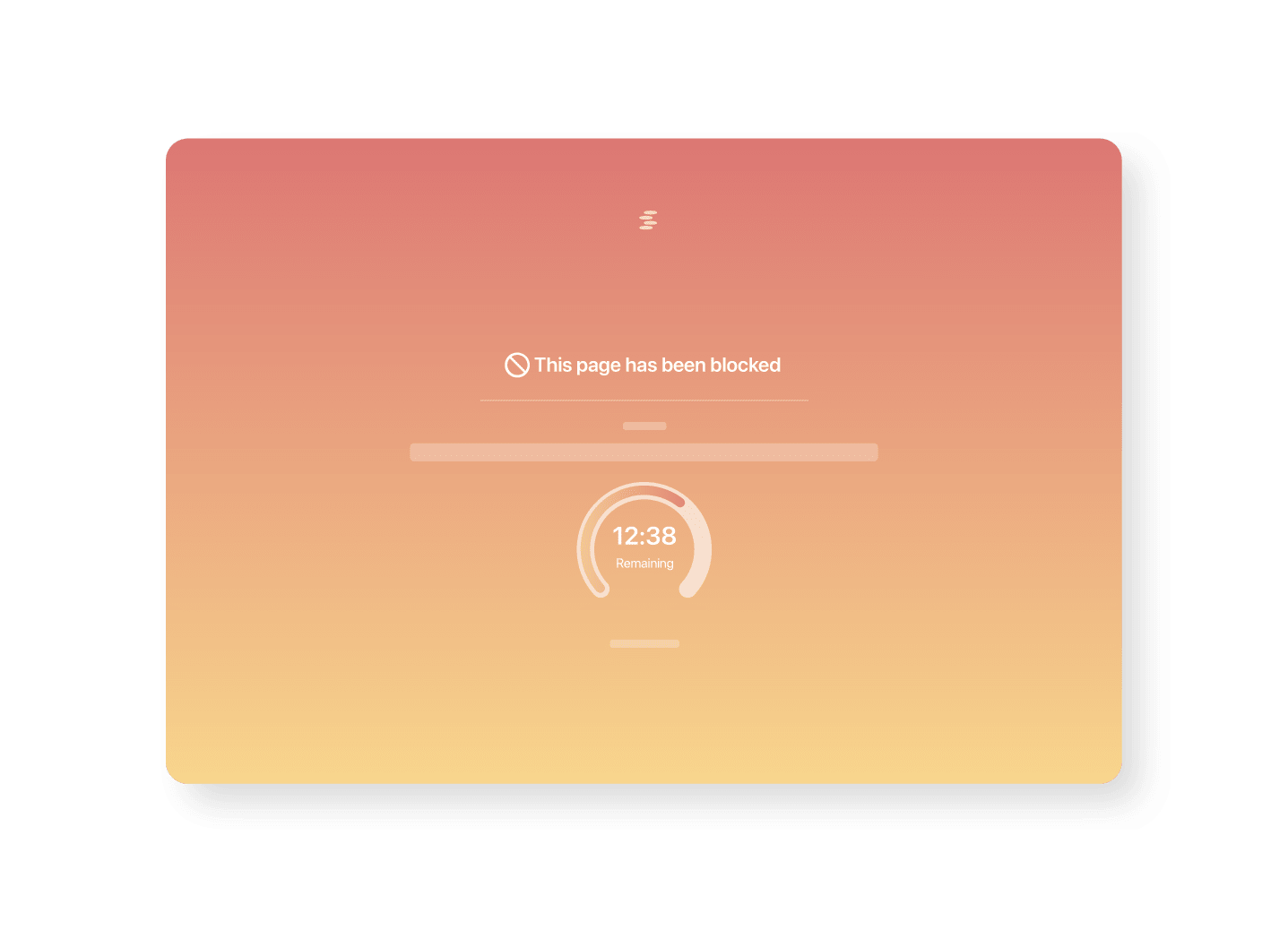
Serene blocks websites and apps that get in the way of your workflow so that you’re never distracted during your sessions. You can forget about those pesky email notifications, messages from your team members or the temptation of a quick Twitter browse.
Welcome to truly distraction-free work sessions.
#3: Create a dedicated workspace
For a lot of remote workers, their home becomes the office and staying focused in a house full of distractions is difficult. The couch is temptingly comfortable, the cupboards are filled with snacks and there’s always a household task that’ll only take a minute to quickly do (and then take 23 minutes to refocus from).
I have to hold mt hands up and say I’m a sucker for home distractions.
For years, my preferred solution was to work in cafes and this is still my go-to option when I’m travelling. You can’t really create an office in a hotel room (toilets don’t count) but, if you’re working from home, you absolutely do need to create a dedicated working space.

Ideally, this wants to be a separate office room where you can close the door and shut out the rest of the world. You’ll want to keep your home office minimal in terms of design and make sure you keep it tidy – a clear working space keeps a clear mind.
Everything you need should be within touching distance and everything you don’t should be in another room.
Also, I can’t emphasise enough how important it is to have a comfortable chair that helps you maintain a healthy posture. I also like a desk with a raised section or shelf that I can place my laptop on and work standing up for alternating 25-minute blasts.
There are all kinds of office design principles you can use to boost productivity, too. Career coach and startup strategist, Heather Rees, covers these design tricks (and more) that increase productivity in her article for Lifehack.org:
- Lighting: Particularly, maximising natural light and replicating it as much as you can with your artificial lighting.
- Chair and table: Invest in a decent chair or pillows and make sure your table is at the right height for you.
- Clutter: Like I said earlier, keep that home office clean.
- Colour: Choose colours associated with action and productivity, such as blue and orange.
- Temperature: Relatively warm but comfortable temperatures have been found to improve productivity.
- Room scent: Pine scents have been found to increase alertness while cinnamon improves focus, lavender helps combat stress and peppermint lifts your mood.
- Noise level: Most styles of music reduce productivity but focus music or natural sounds (rainforest, ocean waves, etc.) have been found to have a positive impact.
- Air quality: Open up those windows and let some fresh air in, get an air filter and fill your room with plants.
- Refreshment: Make sure you have enough water to hand and minimise your number of trips to the kitchen for drinks and snacks (save this for break times).
- Plants: Aside from improving air quality plants have been found to lift moods and boost productivity in a variety of studies.
Obviously, the ideal home office is a subjective thing and it’s up to you to decide whether plants and air filters help you get more done (or feel better while doing it). For me, now that I’ve started travelling less and working from home more, my priority was to create a minimal working space with no distractions.
I can always go to a cafe when I feel the need to be in a more public setting.
#4: Switch off after working hours
One of the biggest problems with remote working is that life becomes work. The divide between the two disappears and this, for me, is the biggest challenge of being a remote worker. I’m not alone, either, because this tops the list of remote workers’ struggles in Buffer’s 2019 State of Remote Report.
A 2017 report from the Chartered Institute of Personnel and Development (CIPD) found that almost a third of all UK workers feel that having remote access to the work means they’re unable to switch off in their personal time.
Clearly, this is a contradiction of the improved work-life balance remote working is supposed to achieve, which negatively impacts many of the other benefits it should come with.
Businesses need to allow their remote workers to genuinely switch off once their working hours are done and employees need to need to allow themselves to do the same – another pressure we often fall victim to.
#5: Make available hours visible to everyone
To make sure everyone gets the chance to switch off, we share our default working hours with each other so everyone knows when they’re able to contact each other. I say default working hours because these can vary but most of us find we’re more productive when we try to stick to a fairly regular working routine.
Generally speaking, the more consistent we are with working hours, the less work tends to eat into our free time.
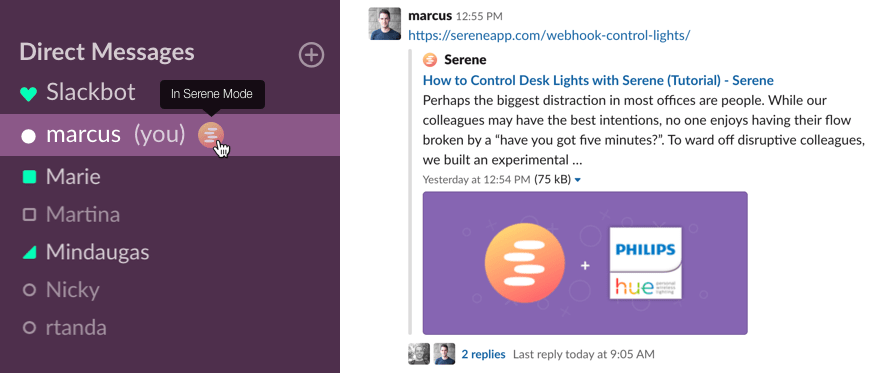
We also integrate Serene with Slack to constantly update our status so team members can see when we’re focused on a task and we’re not to be disturbed. Finally, we can also manually set our availability statuses, allowing everyone to collaborate without getting in each other’s way.
#6: Make current tasks visible to everyone
Making our work hours and availability statuses visible to everyone prevents unnecessary distractions/interruptions, but it doesn’t provide any kind of context about what team members are actually doing while they’re busy.
This can be problematic from a project management perspective because you need to know people are working on the right task and keeping on track. The thing is, you want to know this without having to pester them every five minutes, asking them what they’re doing and whether they’ve finished X, Z or Y.
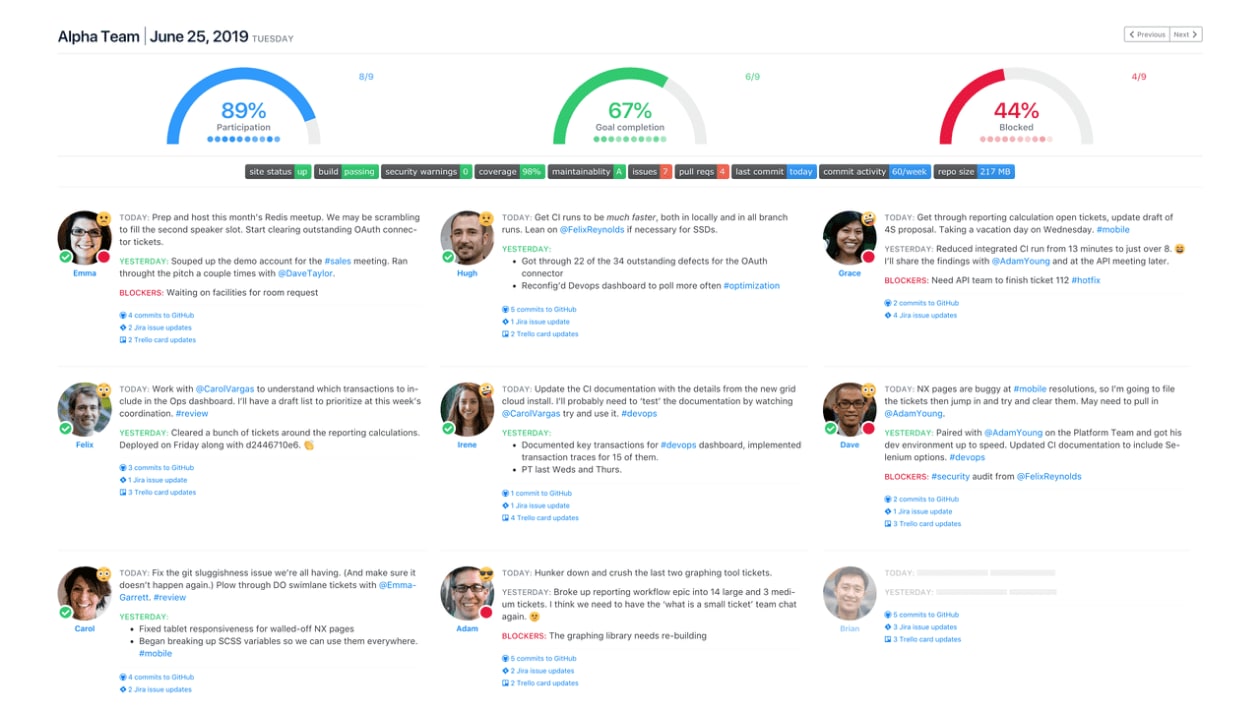
We use StatusHero to keep everyone informed of what we’re doing so team managers can get a better idea of progress without interrupting people’s workflow. This also allows other team members to see what each other are working on, which also reduces interruptions on collaborative tasks.
Team members can also post blockers getting in the way of tasks, helping you to address the biggest barriers to progress on your project goals.
#7: Choose the right collaboration tools
This one is so important for remote workers and finding the right collaboration tools for your entire team requires some consideration. It took us years of trials and experimentation to find the right mix of tools for our team and our needs have changed over this time as well – as will yours.
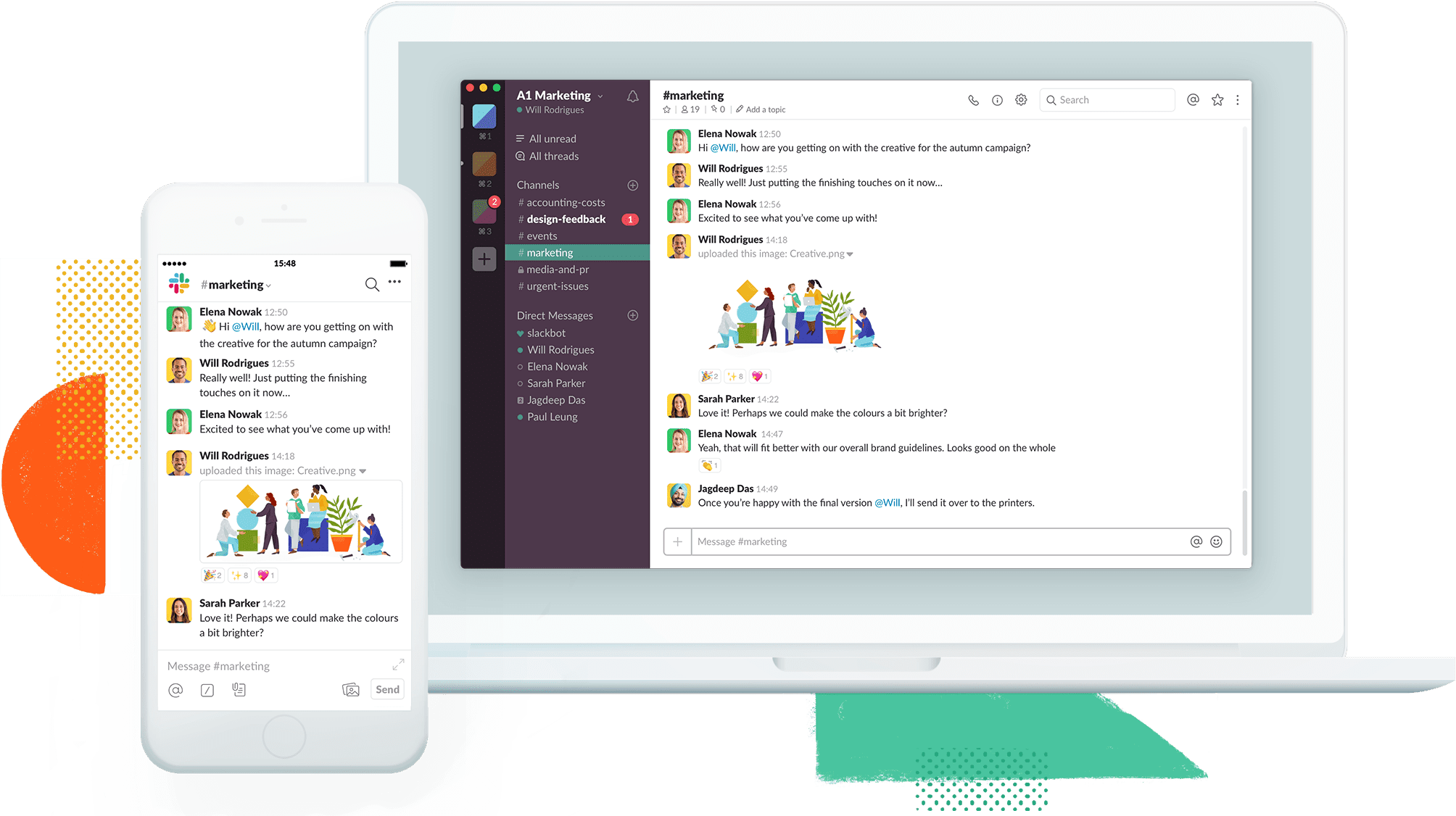
We’ve already looked at how tools like Serene, Slack and StatusHero help our remote team maximise productivity and you’ll find plenty of other examples in our article, 53 Business Automation Tools That Skyrocketed Our Growth by 330%.
Also, be sure to take a look at our in-depth article on the 10 best productivity apps for teams.
#8: Choose the right project management tools
Having a remote team can make it more challenging to manage tasks and track progress. This is where you need the right project management tools on your side to ensure everyone is on track with the broader objectives. Once again, Slack is a fine choice for this while Trello and monday are also strong options for an all-in-one project management and collaboration solution.
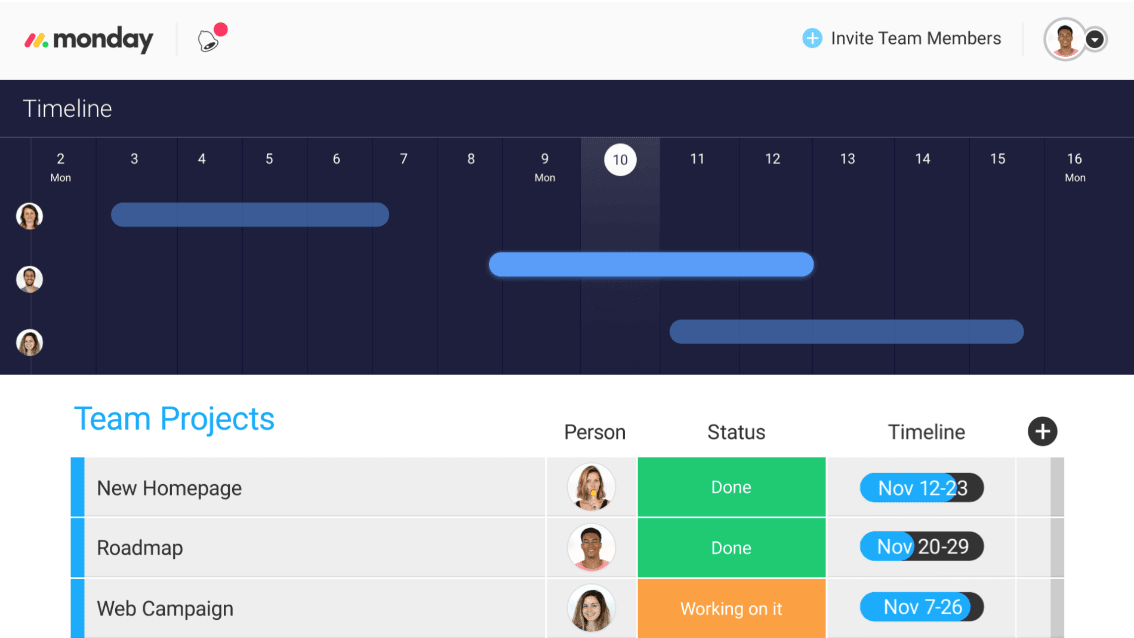
It’s also important to bring the team together (even if only digitally) to discuss progress, obstacles and ideas. Above all, this keeps people accountable for their goals and provides a constant reminder that their individual tasks are part of a team effort.
We hold traction meetings every Monday on Zoom for everyone to discuss how they’re getting on and raise any problems they might have.
Without these meetings, we’ve found that deadlines are met less frequently and simple issues getting in the way of productivity were never raised to the right people. It seems our weekly traction meetings provide just the right amount of motivational pressure for people hit targets without them overmanaged.
They also demonstrate how hitting these targets (or not) impacts other team members.
#9: Respect cultural differences, not just time zones
This one is so important if you have a team of remote workers spread out around the world. While there are plenty of tools that can help your team collaborate across different time zones, you can’t rely on technology for everything. Managers and team members alike need to have a genuine, human understanding of the cultural differences that make up a global group of remote workers.
Some aspects of this are easier than others and there are always going to be misunderstandings when you bring culturally diverse people together. However, it’s imperative you’re able to create a business culture of understanding between your team members.
Here are some key areas to consider:
- Holidays: Not everybody celebrates Christmas and there are plenty of religious events around the world unique to other cultures that may, among other things, require certain team members to take time off.
- Language: Language proficiency is obviously a factor and there are distinct differences between languages irrespective of fluency that can lead to misunderstandings.
- Openness: Some cultures promote openness as a positive virtue while others encourage people to keep certain thoughts (particularly negative ones) to themselves.
- Agreeability: Likewise, in some cultures, there can be a reluctance to say “no,” refuse or say that something can’t be done. I’ve personally seen this in many Asian countries where people can feel compelled to take on tasks they’re not fully comfortable with or don’t have the time to take on.
- Hierarchy: This is a fundamental principle in many cultures and simply being older can give someone authority in many societies.
- Work ethic: The expectations placed on people in the workplace can vary a lot, too.
- Workers rights: The level of workers rights in cultures has a large impact on how people conduct themselves in the workplace – for example, how many breaks a person might expect to take during the day or how many hours they want (or feel compelled) to work.
- Bereavement: The practice and duration of funerals can vary a lot, as well as the wider cultural process of bereavement.
- Individualism: It’s also really important to understand that someone’s cultural background doesn’t define who they are. People are still individuals and some of us a more “British” or whatever else than others. The aim is to understand cultural differences, not pigeonhole people with cultural labels.
I think the easiest place to start with this is holidays because it provides a quantifiable, visual (at least in calendars) pathway into cultural understanding within teams. Remote workers can see certain team members have days off for public holidays, religious events or other reasons.
Take the next step, though, and encourage team members to understand more about these events. Ramadan is a great example of this, where practising Muslims fast during daylight hours for a month – something that can obviously impact a person’s mood or efficiency. There are plenty of Muslim athletes who continue to perform at the highest level during Ramadan but it’s important to understand how difficult it can be to maintain performance.
Above all, team managers need to understand the differences that come with cultural variety and respect those differences. Most of the challenges that arise from cultural differences can be resolved or mitigated with communication and it’s also worth recognising the benefit of having alternative perspectives when it comes to making creative decisions.
#10: Create guidelines for every team member
Remote working comes with a lot of added freedoms but flexibility isn’t always a good thing. There are certain tasks that need to be completed to specific requirements, within specific timeframes. For example, your blog posts might need to be published to Twitter at certain times of the day and there are certain things those posts should/shouldn’t include.
Likewise, you don’t want your social team putting out an image or status update that damages your online image. Or someone to accidentally email the wrong invoice to a client who can now see how much you’re charging someone else for similar services.
Having the freedom to work anywhere is great but there are some tasks that probably shouldn’t be done on public WiFi in a cafe. Remote teams need guidelines, too.

Should your team really be working on that in a cafe?
Guidelines are there to help your team members complete tasks properly and avoid simple, but costly mistakes. They also provide a reference for complex tasks that people can go back to for reminders and make it easier for other team members to take on new tasks.
Guidelines are about support as much as they are regulation.
#11: Get things started in the office
While some of our team members are spread out across the world, whenever possible, we try to get new staff members working in our office for the first two weeks at Venture Harbour. This allows us to start the working relationship in-person and provide a greater level of training and support as new team members get used to their roles.
We have a specific way of working here at Venture Harbour and this isn’t something you can communicate effectively through emails. It’s also very important to us that remote working doesn’t remove the human element of being a part of our team.
For our overseas team members, we rely on video calls and group voice calls to try and provide a similar kind of introduction for new recruits. But it’s always a smoother process when we’re able to get people into our offices for their first two weeks with us.
#12: Bring the team together
As we can see from Buffer’s 2019 State of Remote Report, loneliness is the second biggest struggle participants said they experience while working remotely. There are a lot of things we can do to make sure this isn’t a problem for our team members:
- Make sure people have enough free time to build and nurture relationships outside of work.
- Build working relationships within the team.
- Use collaboration tools that put faces to names.
- Create group chats for non-work-related discussions.
- Congratulate people on their birthdays, important events, etc.
- Get the team together regularly.
Here at Venture Harbour, we get the whole team together once a month for a casual meetup. We use this as more of a social/team-building exercise but it also gives everyone a chance to discuss things face-to-face and raise any issues or suggestions to the group.
We also get to laugh at how different everyone sounds in real life, compared to video/voice calls.
Twice a year, we whisk the entire team away for a 3-4 day retreat to an epic AirBnB location to develop new ventures, explore new technologies, teach each other skills… and have a lot fun.
Want to be a part of the next one? 👉 https://t.co/cQTATuT8pd pic.twitter.com/Ci0Jhyryn5
— Venture Harbour (@VentureHarbour) March 21, 2018
Aside from the monthly meetups, the Venture Harbour team also gets together for retreats twice a year. This is where we put our minds together and come up with new venture ideas, consider new technology solutions and address business challenges. It’s not all about work, though. The retreats give us a chance to have some fun together, build a stronger working relationship with each other and bring the team closer together.
Without these kinds of meetups, your team is going to be a bunch of strangers working on projects together and the internet will be the only connection between them.
Making remote working… work
Remote working creates a lot of benefits for businesses and employees alike but there’s no such thing as a perfect working model. As with anything, there are pros and cons with remote working, but you can overcome many of the negatives and, at the very least, mitigate the rest.
Overcome these challenges and remote working will add far more to your business – and the lives of your team members – than it takes away.
To do this, you’ll need to create a business culture that encourages remote working and helps team members overcome potential barriers – both collectively and personally. The best practices we’ve looked at in this article have come from years of in-house and remote team working together. We’ve made plenty of mistakes along the way but we’ve learned from every one of them and turned these lessons into working processes that help remote workers get more done, faster.
Now, our team is more efficient than ever, which is great news for business and also for our team members who can feel happier about their work and spend more of their free time actually living their lives. However, we’re still constantly looking at our working setup to look for new opportunities to improve efficiency and work-life balance.
We’re not aiming for perfection but we are aiming to get better every year.




